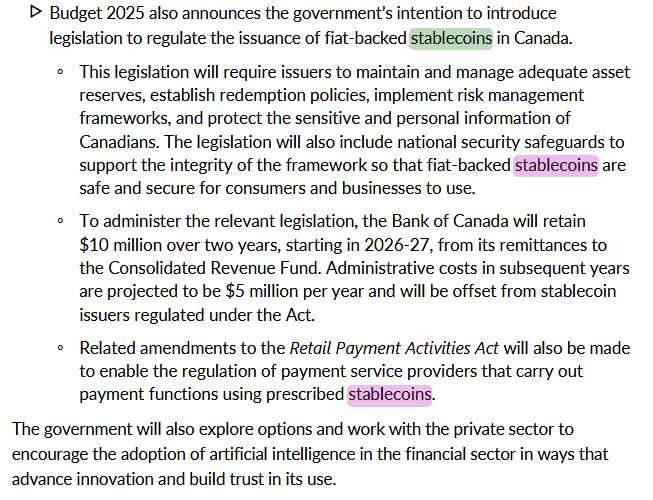Canada Takes a Major Step Toward Regulating Stablecoins
Canada is finally drawing clear lines around how stablecoins will operate within its financial system. The 2025 federal Canada budget unveiled a plan to introduce national legislation that regulates fiat-pegged stablecoins, aiming to make them safer for consumers and more transparent for businesses. This move follows months of discussions between government officials, regulators, and industry players—and reflects Canada’s growing intent to catch up with global efforts to bring order to the digital asset economy.
The proposed framework is designed to balance innovation with accountability, ensuring that stablecoins don’t undermine financial stability or national security. Here’s what Canada’s new approach means for the industry, the economy, and the broader global crypto landscape.
Stronger Oversight for Stablecoin Issuers

The new legislation will require stablecoin issuers to hold adequate reserves, establish clear redemption policies, and implement robust risk management frameworks. It will also enforce strict privacy measures to protect users’ personal data. According to the budget, these measures are meant to ensure fiat-backed stablecoins remain secure, trustworthy, and fully redeemable. National security safeguards will be embedded into the framework to prevent misuse or systemic risks.
The Bank of Canada’s Role and Cost Recovery
To manage the framework, the Bank of Canada will retain $10 million from its Consolidated Revenue Fund remittances across two fiscal years starting in 2026–27. After that, ongoing costs—estimated at around $5 million annually—will be covered by fees from regulated stablecoin issuers. This model ensures the regulation is self-sustaining, shifting the cost burden from taxpayers to industry participants.
Expanding the Regulatory Net
In parallel, the government plans to amend the Retail Payment Activities Act to cover payment service providers that use stablecoins. This will close existing gaps in oversight and ensure that both traditional and digital payment systems operate under consistent regulatory scrutiny.
Behind the scenes, officials from the Department of Finance and other agencies have been engaging in deep talks with stakeholders to define stablecoin classifications and avoid capital flight toward U.S.-based tokens . While the final decisions on classification weren’t revealed, the consultations show that Canada is taking a collaborative, measured approach.
Encouraging Safe Digital Innovation
The Canada budget message is clear: innovation is welcome—but it must be safe. The legislation aims to create a trustworthy environment for fintech growth while maintaining strong consumer protections. By introducing clear rules and accountability measures, the government hopes to support responsible development of digital assets rather than stifle it.
Canada Joins a Global Regulatory Trend
Canada’s move comes on the heels of the United States passing the GENIUS Stablecoin Act in July, a law that’s already shaping the global conversation around fiat-backed digital assets. Europe’s Markets in Crypto-Assets (MiCA) regulatio n is already in force, while Japan and South Korea are developing their own frameworks.
With over $291 billion worth of stablecoins in circulation—mostly pegged to the U.S. dollar—the competition to regulate is heating up. Analysts at Standard Chartered even predict that up to $1 trillion could flow from emerging market bank deposits into U.S. stablecoins by 2028.
What It Means Going Forward
For Canada, this isn’t just about control—it’s about credibility. By introducing regulation now, the country is positioning itself as a responsible player in the digital finance space. If executed effectively, the framework could enhance investor confidence, attract legitimate innovation, and solidify Canada’s reputation as a forward-thinking but cautious regulator in the age of digital currencies.
Disclaimer: The content of this article solely reflects the author's opinion and does not represent the platform in any capacity. This article is not intended to serve as a reference for making investment decisions.
You may also like
YFI - Decreased by 44.53% Year-Over-Year as of November 6, 2025 During Ongoing Decline
- YFI fell 0.6% in 24 hours, extending a 44.53% annual decline amid sustained market pressures. - Analysts note bearish technical signals: oversold RSI, weak buying pressure, and failure to breach key moving averages. - A backtesting strategy examines historical 10%+ single-day drops to assess YFI's post-decline recovery patterns and risk profiles.
Ethereum Updates Today: DeFi's 'Code Before Capital' Movement Challenges Centralized Crypto Power
- Major Ethereum DeFi protocols form EPAA to counter centralized crypto firms' influence in U.S. policymaking and promote onchain solutions in regulation. - The alliance, managing $100B+ in assets, emphasizes technical pragmatism over financial lobbying, collaborating with groups like DeFi Education Fund. - Unlike centralized PACs like Fairshake ($260M raised), EPAA provides policymakers with blockchain insights on smart contracts and decentralized governance. - With no formal leadership, the coalition aim

ZEC Climbs 3.55% as Investors Show Support and Derivative Positions Expand
- Zcash (ZEC) surged 3.55% in 24 hours, hitting $490.4, driven by institutional interest and endorsements from figures like Naval and Arthur Hayes. - Derivatives markets show growing speculative demand, with a $13.7M leveraged long position on Hyperliquid reflecting heightened bullish sentiment. - Privacy coin sector valuation rose 2.9% to $25.5B, supported by ZEC's 780% year-to-date gains and increased trading volume of $3.87B. - Technical backtests analyze ZEC's 5%+ daily surges as momentum signals, with
DASH Drops 13.71% Following Q3 Earnings Shortfall and Announcement of 2026 Investment Strategy
- DoorDash's Q3 2025 earnings showed revenue above estimates but EPS below, leading to a 13.71% post-earnings stock drop. - Despite strong 25% YoY GOV growth and 13.8% net margin, 2026 investment plans raised short-term margin concerns. - Deliveroo acquisition's adjusted EBITDA contribution dropped by $32–$40M in 2026 due to accounting adjustments, adding investor uncertainty. - Backtesting suggests EPS misses correlate with downward price pressure when paired with significant capital allocation announceme
